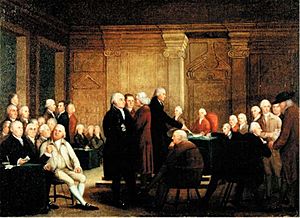Continental Congress facts for kids
The Continental Congress was a special meeting where important people, called delegates, from the thirteen original American colonies came together. Delegates were chosen by the people to speak for them in big meetings. These delegates made important decisions for the colonies during the time of the American Revolution, when they were fighting for independence from Great Britain.
Contents
First Continental Congress: A Call for Fairness
The First Continental Congress was a group of 56 men from 12 of the 13 colonies. Only delegates from Georgia could not make it to this first meeting. They met in Philadelphia, Pennsylvania, from September 5 to October 26, 1774. Some famous delegates included George Washington, John Adams, and Patrick Henry.
The people in the colonies were not happy with how Great Britain was treating them. They felt that Great Britain had too much power. The king had even passed strict laws called the Intolerable Acts. These laws were meant to punish the colonies, especially after the Boston Tea Party. Some colonies wanted to completely break away from Great Britain and rule themselves. Others just wanted King George III and the British Parliament to treat them more fairly.
The delegates wrote to King George III. They told him that if he did not stop the Intolerable Acts, the colonies would stop buying products from England. This action is called a boycott. Before their last meeting, the delegates decided that if the king did not listen, they would meet again in May 1775. King George did not respond as they hoped. The American Revolutionary War began in April 1775, even before the next meeting.
Second Continental Congress: The Fight for Freedom
The Second Continental Congress first met on May 10, 1775. One of their first big tasks was to create an army. They chose George Washington to be the General of the new Continental Army. The colonies needed organized soldiers to fight the British.
The delegates also tried one more time to make peace with the king. They sent a special letter, called a petition, to King George III on July 8, 1775. They asked him to talk to Parliament for them. But King George refused to even see the person who brought the letter. On August 23, he announced that the colonies were rebelling against Great Britain.
The king's announcement pushed the colonies further into war. The delegates then began writing the Declaration of Independence. This important document was officially released on July 4, 1776. With this, the thirteen colonies were on their way to becoming an independent nation.
Key Moments of the Continental Congress
1774
- September 5: The First Continental Congress meets in Philadelphia.
- October 26: The First Continental Congress ends, agreeing to meet again if their problems were not solved.
1775
- April 19: The American Revolutionary War begins with battles at Lexington and Concord.
- May 10: The Second Continental Congress meets in Philadelphia.
- June 14: Congress creates the Continental Army.
- June 15: George Washington is chosen as the commander of the Continental Army.
- July 8: The "Olive Branch Petition" is sent to King George III, asking for peace.
- August 23: King George III declares the colonies are in "open rebellion."
- October 13: Congress creates the Continental Navy.
- November 10: Congress creates the Continental Marines.
1776
- January 10: Thomas Paine publishes Common Sense, a pamphlet arguing for independence.
- June 7: Richard Henry Lee suggests that Congress declare independence.
- June 11: A "Committee of Five" is chosen to write the Declaration of Independence. Members include Thomas Jefferson, John Adams, and Benjamin Franklin.
- July 2: Congress votes for independence from Great Britain.
- July 4: The final text of the Declaration of Independence is approved.
- August 2: Delegates sign the Declaration of Independence.
1777
- November 15: The Articles of Confederation, the first constitution for the new United States, are approved and sent to the states to be ratified.
1781
- March 1: The Articles of Confederation officially become law after all 13 states approve them. The Continental Congress becomes the Congress of the Confederation.
- October 17: British General Cornwallis surrenders at Yorktown, a major victory for the Americans.
1783
- January 14: The Treaty of Paris is approved, officially ending the Revolutionary War.
- December 23: George Washington resigns as commander of the Army.
1787
- May 25: The Constitutional Convention meets in Philadelphia to write a new constitution.
- September 17: The United States Constitution is completed.
- September 28: Congress sends the new Constitution to the states for approval.
1788
- July 2: New Hampshire becomes the ninth state to approve the Constitution, meaning it can now become law.
1789
- March 2: The last meeting of the Continental Congress takes place.
- March 4: The first session of the new 1st United States Congress begins under the new Constitution.
- April 30: George Washington becomes the first President of the United States.
See also
 In Spanish: Congreso Continental para niños
In Spanish: Congreso Continental para niños


